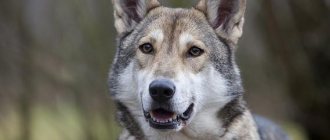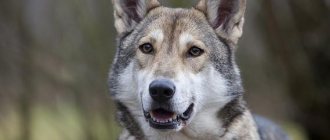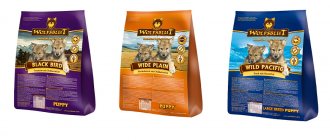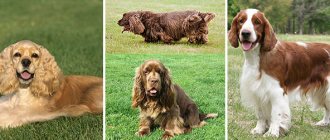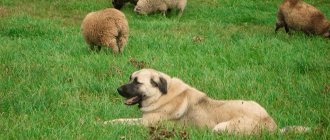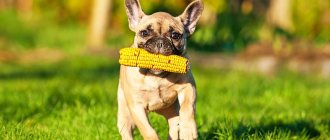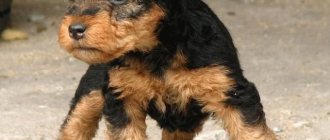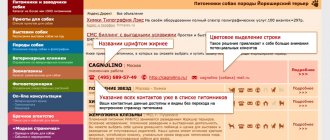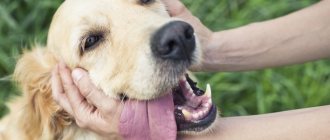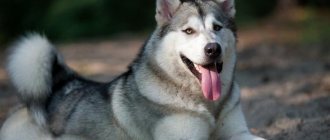- Pets
- >>
- Dog breeds
* Here is a photo of a typical representative of the Czechoslovakian Wolfdog breed . You can send us photos of your animals by email, and we will post them on the website. Don't forget to send your pet's name.
Other breed names:
Czechoslovakian Wolfdog
Brief description of the breed
What is the actual country of origin?
Czechoslovakia
What is the country of origin according to the FCI?
Czechoslovakia
When did the breed appear?
1999
How long does he live?
from 12 to 14 years
How much does a male dog weigh?
from 25 to 29 kg
How much does the bitch weigh?
from 19 to 26 kg
What is the height (height at withers) of a male dog?
from 62 to 67 cm
What is the height (height at withers) of the bitch?
from 58 to 64 cm
How much does a puppy with documents cost?
from 15 to 60 thousand rubles
What is the price of a puppy without documents?
from 5 to 15 thousand rubles
The Czechoslovakian Wolfdog is a unique breed of dog that appeared relatively recently. This is a successful experiment, which showed that it is possible to cross a dog and a wolf, thereby obtaining excellent dogs with guard qualities. Czechoslovakian Wolfdogs are hardy, active and friendly towards close people, which makes them irreplaceable guards and reliable companions.
Wolfhund price and owner reviews
to buy a purebred Wolfhund in the CIS. In our regions it is not often possible to find nurseries for breeding these breeds. Although over time, Wolfhounds become popular and professional breeders began to increasingly focus on breeding these breeds.
Wolfhund puppies in the photo
The price of a Wolfhund can be from 50 to 120 thousand rubles, depending on the purity of the breed, age and color of the animal. Before purchasing such a dog, you need to make sure that the seller is reliable and that the accompanying documents are available.
According to reviews from professional dog breeders, Wolfhund dogs are very devoted and loyal to their owners. They have a negative attitude towards violence and shouting.
Some pets are great at following the trail and can help in any search. Confined spaces have a bad effect on the dog’s general condition; frequent walks in the fresh air significantly improve the pet’s tone.
Video
* We invite you to watch a video about the Czechoslovakian Wolfdog . In fact, in front of you is a playlist in which you can select and watch any of 20 videos about a given dog breed by simply clicking on the button in the upper right corner of the window. In addition, the material contains quite a lot of photos. By looking at them you can find out what a Czechoslovakian Wolfdog looks like.
In this article:
|
History of the origin of Czechoslovakian wolfdogs
The Czechoslovakian Wolfdog, also known as the Czech Wolfdog, has an open history of origin. This sets it apart from many other breeds that have dark spots in their history. The Czechoslovakian Wolfdog emerged through deliberate experimentation in the mid-twentieth century.
The socialist government of the Czech Republic in 1955 had one of the military canine goals: obtaining a hybrid of a wolf and a dog. Similar experiments have already been carried out in different countries of the world, but were not successful - the wolf element always won in the dog, and they ran wild.
Czech breeders were confident that wolves and dogs do not have a common ancestor, so they can produce good offspring after crossing, and these offspring are fertile. This point is especially important since many attempts to cross a wolf and a dog have produced completely sterile offspring.
The breeding of the Czechoslovakian Wolfdog was carried out under the supervision of Karel Hartl, a representative of the Czechoslovakian army. Four wolves were caught and named Lady, Sharik, Brita and Argo. They also selected 48 purebred German shepherds, the best representatives of their breed. The first offspring of wolves and shepherd dogs turned out to be fertile.
For ten years, this crossing produced fertile offspring. The resulting individuals had an interesting exterior and a unique character, not similar to either a dog or a wolf. These dogs rarely barked and behaved extremely reservedly.
Interesting fact: The experiment was completed in 1965, and the government of Czechoslovakia was completely satisfied with the result. The Czechoslovakian Wolfdog was introduced into border work and began to be bred for government and military needs, including in private nurseries.
In the nineties, the Czechoslovakian Wolfdog was exported to Europe, where breeders became interested in it. Then it was recognized as a separate breed, which is listed in cynological organizations.
How to choose a puppy
- Czechoslovakian Wolfdog females are less adventurous and more manageable than males, so if you want to make it easier for yourself to train your pet, choose “girls”.
- The optimal age for purchasing a puppy is 2-3 months. It is undesirable to take older animals due to the fact that the older the animal, the more difficult it is to socialize it and raise it “for yourself.”
- If you plan to have breed exhibitions, carefully study the documents of the litter producers: examination for the presence of genetic diseases, results of psychological testing (T1), grading code data.
- Don't buy a wolfdog puppy right away. It’s better to book a baby and visit him several times - this way you will see how the Czechoslovakian Wolfdog develops and what character traits it acquires.
- When choosing the most active and courageous puppy, remember that such individuals grow into leaders, who then have constant problems with obedience.
- It would be great if at least one of the litter's sires comes from Czech nurseries, since the best representatives of the breed still live in the territory of the former Czechoslovakia.
- Check whether the seller is ready to provide consulting support to its customers. In serious nurseries, puppies are usually “trained” throughout their entire lives, which is especially valuable for beginning fans of the breed.
Czechoslovakian Wolfdog - description of the breed
The first two generations of dogs, bred from wolves and German shepherds, were more similar to shepherds, but had improved characteristics. Only in the third generation did the dogs appear to have more wolfish exterior features. Now the external characteristics of the wolf have become dominant, and are also passed on to other generations.
The Czechoslovakian Wolfdog is a large animal. Her body is rectangular in shape, her muscles are well developed. The entire constitution of the dog is well adapted for running and long jumps. The muzzle has clear, pointed lines.
The nose is oval in shape, strictly black. The bridge of the nose is straight, even, without humps. The lips are dry and thin, fitting tightly to the teeth, but not exposing them. The jaws are strong, with a straight or scissor bite.
The eyes are slightly slanted, with a prominent yellow iris. Planted not deeply, at a moderate distance from each other. The brow ridges are pronounced, which makes the look of the Czechoslovakian Wolfdog expressive.
The ears are triangular in shape and small in size. The cartilage in the ears is dense, thick, and pointed at the end. The ears are always level, like those of German Shepherds. The ears are covered with smooth, short hair, including short stubble inside.
The tail is set high. In a calm state, it hangs with the tip down, but at the slightest excitement the dog lifts it with the sickle up. These dogs rarely wag their tail. The legs of the Czechoslovakian Wolfdog are long and well-muscled. Sometimes extra toes grow and are removed from puppies.
Popular colors of Czechoslovakian wolfdogs
The coat of the Czechoslovakian Wolfdog acquired the best qualities from its ancestors - German shepherds and wolves. The guard hair is thick, hard, completely covering the entire body of the dog. The coat is strictly straight, without curls or wavy areas.
The wool is different in winter and summer. By winter, dogs are insulated with a thick, thick undercoat of soft fluff, and thanks to the dense layer of guard hair, the undercoat does not release heat. This makes the Czechoslovakian Wolfdog extremely resistant to cold weather. A dense layer of winter fur covers not only the body, like many dogs. It even covers the belly, the inner thighs, the inside of the ears and the paws between the toes. This is the most invulnerable dog to cold weather.
Interesting fact: In the summer, the Czechoslovakian Wolfdog sheds its thick undercoat, which causes it to noticeably lose weight. Mittens and scarves can be knitted from the undercoat of dogs of this breed, and some attribute healing properties to it and make medicinal belts from it that provide good warmth.
The color of the Czechoslovakian Wolfdog resembles that of a wolf. The base hair can vary in color from yellow-gray to silver. At the same time, the color of the guard hair is uneven, but is distributed as if by a gradient, so the dog can combine several shades at once.
A mandatory attribute of a dog's color is a mask that is lighter than the dog's main color. Similar light hair should be present on the neck and chest. The standard also allows dogs with a darker, gray color and a light mask on the face.
Wolfhund species
The three branches of the breed were not created at the same time. The first was Saarloos's dog. She is not Czech, but Dutch. The selection was carried out by Lander Saarloos, after whom the breed is named. It was recognized by the FCI back in 1981.
The crossing of the she-wolf Flera and the male German shepherd was carried out back in 1925. Actually, the Czechoslovakians acted on the basis of these experiments, creating their own wolfdog in 1955. He turned out to be slightly smaller than Saarloos's dog. The difference in the withers is approximately 5 centimeters. The wolfdog also has a darker color.
Among the dogs of Saarloos there were many whitish ones. However, by 2018, there were only a few purebred representatives of the breed left. The number of Czechoslovakian thistles is stable.
Saarloos Wolfhound
The height of the wolf dog is 65-70 centimeters for males and 60-64 centimeters for females. The weight of the latter is 20-27 kilograms. The weight of males is from 26 to 32 kilos. Litters of 4-6 puppies are typical for representatives of the breed. Their lifespan is on average 12-14 years. The Saarloos Wolfhund lives about the same as the Czech Wolfhund .
Wolfhund became Czech from Czechoslovakian after the collapse of the USSR and the division of Czechoslovakia into two states. Moreover, despite the name of the breed, the FCI gave the rights to it to Slovakia.
The Czech wolfdog, as mentioned, was recognized by the FCI in 1993. But the third type of breed - the Russian Wolfhund remains unrecognized. Otherwise, representatives of the breed are called wolf-dogs. They were brought out already in the 21st century. Selection was carried out in St. Petersburg.
Russian Wolfhund or Wolfhound
Wolves were crossed with Malamutes, large Alaskan sled dogs. Therefore, the Russian version turned out to be tall. Males reach 83 centimeters, and females 79. At the same time, the weight of males is 28-38 kilograms. The weight of females ranges from 23 to 34 kilos.
The size of Russian Wolfhounds is partly due to wolf blood. There are more than 10 species of grays in the world. One of the largest is Canadian. It was he who participated in the breeding.
The color of the Russian Wolfhund is black with a white marking on the chest. On the paws and along the bottom of the body, the fur is also lightened, as if grayish.
Russian wolfdogs live 1-2 years less than Czech ones. This is due to the large size. Large dogs rarely live long lives.
Russian Wolfhound litters are also small in number. There are rarely more than three puppies. The FCI classifies them as hybrids, while the first two types of Wolfhounds are recognized by the organization as dogs.
Character and habits of Czechoslovakian wolfdogs
The character of the Czechoslovakian Wolfdog differs from both the German Shepherd and the wolf. This breed of dog is not suitable for new breeders, since dogs need to be educated competently, with a steady hand and canine skills. This is a large service breed dog with a serious character.
No, the Czechoslovakian Wolfdog does not have a tough temperament, but it can feel like the leader of the pack, trying to get the upper hand over its owner. A person must be an unconditional authority for such a dog.
The Czechoslovakian Wolfdog is a devoted companion who is ready to sacrifice his life for its owner. For such a dog, the pack is the main priority, so the animal has a well-developed sense of collective and hierarchy. The owner of such a dog will be its leader.
These dogs are very brave. They do not assess the danger to their owner or family, but immediately rush to defense. These dogs cannot be frightened by loud noises or large size, as they have a wolfish agility and ferocity in battle.
The Czechoslovakian Wolfdog is a very independent, intelligent animal. She is able to assess the situation and think during critical moments. In a special situation, a friendly dog becomes calm and acts decisively with amazing calculation. For example, a dog is ready to save a drowning person without the owner’s command.
Interesting fact: These dogs have innate guard qualities. They clearly understand which territory belongs to them, so they are ready to protect it from an early age. Because of this, dogs do not trust strangers and are ready to drive away even family friends if the owner does not let them know that people can be trusted. A stranger will not be able to win a dog over to a trusting relationship on his own.
At the same time, in relation to the family, the Czechoslovakian Wolfdog is very welcoming and friendly. They get along with other dogs and cats, and can even become friends with these pets. The main thing is not to have two males - they can start competing. These insightful and sociable dogs learn new commands with interest and are ready to make contact if this is required of them.
Training
You should start raising a representative of the breed early, no later than 2.5 months. The formation of his correct character depends on this. A wolf-like dog is prone to aggression by nature. Therefore, her interaction with others must always be adjusted.
@vegard_wolfdog
If a puppy attacks a person or tries to bite him, loudly say the command “No” and push him away from the “victim”. Remember, when interacting with him, no one should show fear. If the dog suspects that one of the household members is afraid of him, he will definitely take advantage of this and try to gain the upper hand, that is, he will begin to dominate. This cannot be allowed.
@vegard_wolfdog
A hierarchical relationship with a domestic service dog is built early. In order for her to grow mentally adequate, she needs to be led on a leash every day. It is twisted in the hand of the leading person so that the dog stands as close as possible. The movement is controlled by its owner. You need to walk along a level trajectory, making stops, during which the animal is mounted on command. This is how he learns discipline.
Already in the first months of home life, the Czechoslovakian Wolfdog can be taught simple and complex commands. He should be helped with them several times, and then he will do what you ask when he hears the command. To make sure your pet obeys, treat him with something tasty.
Important! Remember, corporal punishment is unacceptable when training a dog. You can yell at her to make her feel uncomfortable, but don't hit her.
Interesting facts about Czechoslovakian Wolfdogs
Czechoslovakian Wolfdogs are absolutely fearless. Even puppies of this breed are very brave dogs. For example, puppies are not at all afraid of loud sounds, including thunderstorms. It is noteworthy that almost all puppies of any breed are afraid of the sound of thunder and lightning, so this is very rare among dogs.
The Czechoslovakian Wolfdog proves the thesis that dogs did not descend from wolves. Wolves were not domesticated in ancient times, but only have an ancestor in common with dogs. This was shown by genetic studies conducted on Czechoslovakian wolfdogs. Most dog breeds have more genetic similarities to jackals than to wolves. In turn, Czechoslovakian wolfdogs are more similar to gray wolves than to jackals.
There is a myth that the more wolf genotype a dog has, the more aggressive the dog is. Geneticists working on the Czechoslovakian Wolfdog refute this myth. The fact is that dogs of this breed are calm, calm and friendly with their owners. They show aggression extremely rarely, but they always show the desire to dominate in the pack.
The main character of the film "Balto" is a kind of Czechoslovakian wolfdog, since his mother was a wolf and his father was a dog. Accordingly, the hero of this film is another subspecies of wolf dog.
At Czechoslovakian Wolfdog exhibitions there is a special test that determines the purebred of the individuals. They deliberately try to scare dogs with loud sounds or unusual shapes. If a dog is shy, it will be disqualified from the competition or even from the breed.
Price
You can purchase this wonderful four-legged friend from private breeders or in a nursery. We recommend choosing the first method.
In the Moscow region there is the village of Malakhovka. It is there that high-breed Czechoslovakian Wolfdogs are bred for sale. But, if you dream of becoming the owner of this beautiful dog, which would fully comply with the international breed standard, then you will have to go to a Czech kennel for him.
The price of a Czechoslovakian wolfdog is from 45 to 75 thousand rubles. There is a cheaper option for purchasing – “from hand”. But, in this case, you will not be provided with a pedigree and a passport for the puppy. The cost of selling it to private owners is from 10 to 20 thousand rubles.
Pros and cons of Czechoslovakian Wolfdogs
The Czechoslovakian Wolfdog has undoubted advantages:
- They are absolutely devoted to their owner and family. A trained Czechoslovakian Wolfdog is ready to give his life for loved ones; he will never disobey a command or leave his owner in a crisis situation. For this dog, people are part of the pack;
- These dogs have developed intelligence. They are able to make quick decisions that sometimes save people's lives. These dogs do not rush into danger just like that, but quickly analyze the situation and make the best decisions. Therefore, the Czechoslovakian Wolfdog is an excellent watchdog and companion;
- The complete fearlessness that these dogs possess is the merit of both German shepherds and wolves, which were the progenitors of the breed;
- These dogs are ready to guard the territory or entrusted object until the command is canceled. Puppies begin to show guard qualities at the age of nine months, which is a record early age for guard dog breeds;
- Czechoslovakian Wolfdogs are sociable, but do not impose their company. If they see that the owner is not in the mood or busy, they will not take the initiative to interact. In turn, they are always ready to keep him company or play with him.
The disadvantages of the Czechoslovakian Wolfdog include the following qualities:
- The dog is difficult to control. Only an experienced trainer can find an approach to this breed and raise an obedient dog. If you show softness and pliability, the dog will quickly gain the upper hand;
- Sometimes independence is a negative quality. The dog gets along well without its owner and quickly takes command of those around it. Sometimes they may not listen to people because they have their own opinions;
- If you don't exercise a dog for a long time, it stops being obedient and even shows aggression. Such dogs should not be kept in families with children, as they do not like to be tugged and constantly require communication.
Breeding Czechoslovakian Wolfdogs
Only professional dog handlers are involved in breeding the Czechoslovakian Wolfdog. These are mainly organizations that were state-owned. The peculiarity of crossing the Czechoslovakian Wolfdog is that you need to delicately select individuals for offspring in order to pass on the best qualities to the puppies. Therefore, independent breeding at home is excluded.
Important fact: The Czechoslovakian Wolfdog cannot be crossed with other breeds, including outbred dogs.
The Czech wolfdog is a balance between the wolf and the dog, which can be disrupted in a negative way by improper crossing. You can get a dog with uncontrollable aggression, a disobedient dog, or simply an animal with serious pathologies. Uncontrollable offspring are the most common phenomenon among the facts of illiterate crossing of Czechoslovakian wolfdogs.
The Czechoslovakian Wolfdog's first heat begins at one year of age, which is late for dog breeds. Accordingly, such dogs take a long time to mature and learn faster, since young dogs remember new information better. Estrus occurs only once a year, and during this period the dog should be well supervised. By the first year of life, the bitch should be well trained so as not to cause discomfort to the owners during estrus with her behavior.
Pregnancy and childbirth proceed smoothly. Bitches experience almost no discomfort, everything proceeds as naturally as possible. That is why these dogs give birth on their own, without the supervision of veterinarians. A Czechoslovakian Wolfdog gives birth to about seven puppies. Czech wolfdogs are caring mothers who do not abandon their puppies and take excellent care of them.
Care and feeding
This dog is completely easy to care for. His thick undercoat protects him from low temperatures, so you don't have to worry about him getting cold while living outside. Of course, some people keep a wolfdog in an apartment. But in room conditions he will not be so comfortable. Such an animal is mobile, so it requires spacious terrain for maneuvers.
@cali_the_wolfdog
@pankratova_dasha
In an apartment, it will not be able to run fast, jump, catch up with insects, etc. That is why we advise people living in a country house to choose the Czechoslovakian wolfdog as pets.
You need to make sure that your dog always has free access to drinking water. The food bowl should be next to his sleeping place. A domestic dog becomes more disciplined if it eats at the same time of day. We recommend feeding this pet twice a day. What should I give him?
@axel_wolfdog
There are 2 options for feeding your dog - commercial and natural. In the first case, she eats food, dry or wet, in the second - food from the human table. The owner of a Czechoslovakian Wolfdog does not have to choose only one option; they can be combined.
A young representative of the breed, a puppy, should be given a lot of protein. They are contained in:
- Cheese.
- Cottage cheese.
- Milk.
- Chicken eggs.
- Krupach.
- Bobovykh.
But, the main product that he consumes daily should be raw or boiled meat (turkey, chicken, rabbit). Gradually, the Czechoslovakian Wolfdog puppy needs to be switched to food.
https://www.instagram.com/p/CBB7CKYAow1/?utm_source=ig_web_button_share_sheet
An adult dog of this breed should be given a dry diet twice a day. One serving – 300-400 grams. Also, do not forget to feed your pet with fortified food. We are talking about fruits, berries and vegetables. For example, dogs can be given: apples, bananas, pears, watermelons, apricots, plums, cucumbers, cabbage, tomatoes, etc. They happily eat all of this.
Advice! To keep your pet healthier, give him special vitamin tablets every year. It is advisable to consult your veterinarian first.
The Czechoslovakian Wolfdog is unpretentious in care. He needs to be given drugs against parasites (worms and fleas) 1-2 times a year, brush his teeth and fangs from plaque, wash his eyes to prevent souring and, of course, comb out his fur.
@pankratova_dasha
The dog should be bathed once every six months. She is clean, but can get dirty, especially in bad weather and if she lives on the street. In this case, it needs to be washed additionally in the bathroom. After the procedure, dry your pet with a hair dryer so that it does not catch a cold.
With good care, the Czechoslovakian Wolfdog will live at least 13 years.
Caring for Czechoslovakian Wolfdogs
Czechoslovakian Wolfdogs thrive in outdoor conditions. They are comfortable at any temperature: from severe frosts to hot summers. It is best not to keep the dog on a chain, but to provide it with a free enclosure - this is a more natural habitat for this breed.
The area near a private house will be under the control of the dog, so you can let it go for a walk in the yard without fear - the dog will not leave its area. Although it is better to take care of a strong and high fence that the dog will not jump over if it senses danger. Also, Czechoslovakian wolf dogs, due to their intelligence, can learn to open gates and break locks, so this point is also worth taking into account.
Interesting fact: Even in snowstorms and frosts, Czechoslovakian wolfdogs can sleep in the snow. This does not mean that they do not need a booth: it is worth building a comfortable home, insulated with fresh straw and soft fabric. The dog itself will choose where it is more comfortable for it to spend time.
Due to their compactness and small size, Czechoslovakian wolfdogs also feel good in an apartment. They guard the entire apartment, but at the same time find a favorite place where they spend most of their time. If you choose to keep such a dog in an apartment, then be prepared to walk with it for hours, since these dogs need to use a lot of energy.
These dogs should be brushed once a week and every day during shedding. Although it is worth saying that in outdoor conditions, dogs shed smoothly, so there is no need to comb this breed with excessive zeal.
Since Czechoslovakian Wolfdogs are inquisitive, it is worth giving them the opportunity to explore the world. But these studies often end in bitten furniture in the apartment, so you need to provide the dog with special toys that it will chew.
Diet of Czechoslovakian Wolfdogs
Czechoslovakian Wolfdogs can be fed in two different ways: home-cooked natural food or prepared foods. If you choose the first option, then it is worth considering that the basis of such a dog’s diet is meat.
The meat should not be fatty - turkey, rabbit and chicken should be preferred. Pork should not be given to dogs as it may cause stomach problems. But Czechoslovakian wolf dogs gnaw thick pork and beef bones with great pleasure.
In addition to meat, such a dog’s diet includes low-fat dairy products: cottage cheese, kefir, yoghurt. They provide a calcium supplement. It is also worth giving raw chicken eggs and boiled kidneys, lungs, hearts, liver and other offal. These are useful nutritional supplements that also add variety to a dog’s diet.
Important fact: Low-fat sea fish, which is well frozen or slightly boiled, is especially useful for small puppies. This product is important for lactating bitches, as well as for dogs when they shed, because during shedding they lose many useful trace elements in their bodies.
It is also worth adding cereals: rice, oatmeal, buckwheat. They can be boiled along with meat and vegetables, which are an important dietary supplement for dogs. These vegetables include cucumbers, greens, zucchini and other healthy vegetables. Fruits can be given to dogs as a reward.
Despite the fact that Czechoslovakian wolfdogs are unpretentious in food, when choosing ready-made food, it is worth choosing the premium and super-premium class. These foods are rich in all the necessary vitamins and microelements to keep your dog healthy and energetic.
Diseases and health problems
Czechoslovakian Wolfdogs have good health and strong immunity. They inherited this feature from their closest relatives – gray wolves. A high-quality selection process has made it possible to develop a breed that is completely free of genetic congenital diseases. Despite all this, Czechoslovakian Wolfdogs have a feature that is common to many large breeds.
This is a pathology of the musculoskeletal system, but it is not inherited. Most often it is expressed in hip dysplasia - with this disease, dogs begin to limp and drag their hind legs. Their natural activity disappears, they are reluctant to walk. In the later stages of the disease, complete abandonment of an active lifestyle is possible. This disease can be diagnosed by veterinarians in its early stages and can be treated.
Veterinarians believe that leg disease in the Czechoslovakian Wolfdog occurs due to a number of factors. This includes improper feeding of the dog, in which the animal does not receive enough beneficial microelements. Calcium deficiency in the body especially affects it.
Lack of proper physical activity can also contribute to the development of the disease. Walks with the dog should be long, and an element of serious training is also required, during which the wolfdog realizes his full purebred potential.
If a Czechoslovakian Wolfdog is injured, it should be examined by a veterinarian. Sometimes even a minor injury can lead to significant consequences without timely intervention from a doctor.
